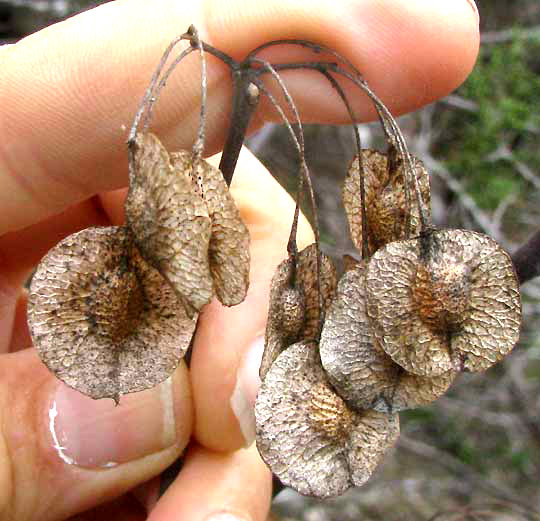Excerpts from Jim Conrad's
Naturalist Newsletter
from the November 25, 2012 Newsletter issued from the valley of the Dry Frio River in northern Uvalde County, southwestern Texas, on the southern border of the Edwards Plateau; elevation ~1750m (~5750 ft); N29.62°, W99.86°; USA
HOPTREE FRUITING
A certain crooked-stemmed shrub or small tree sprouting interwoven branches grows in the shadowy understory of the forest on the alluvial terrace alongside the little Dry Frio River. It's completely winter-leafless now and would be hard to identify, but for its very distinctive fruits, a cluster of which is shown below:

Those fruits, each with a seed suspended in its center surrounded by a network of lacy veins, are pretty to look at when bright light is behind them, as seen below:

Once you've met these very unusual fruits you're not likely to forget the tree producing them. It's the Hoptree, sometimes called Wafer Ash or Stinking Ash. It's PTELEA TRIFOLIATA, a member of the Citrus Family, the Rutaceae. They say that no other member of the Citrus Family lives in the wild farther north than the Hoptree. Of course the Citrus Family is the one bringing us oranges, lemons, limes, grapefruits and the like.
In Mexico we've seen that the leaves of Citrus Family members typically are spicy-pungent, bearing many embedded glands filled with aromatic oils. The Hoptree's leaves similarly are odoriferous, maybe with a hint of lemon fragrance, but mainly the smell is so musky that you understand why some people call it Stinking Ash. The "ash" part of the name is because Hoptree's leaves are trifoliately compound, as ash tree leaves are compound, but beyond that they don't have much in common.
Hoptrees display a spotty and curious distribution pattern in North America and Mexico. They're found in a band from south-central Mexico all the way through here to southern Michigan. They occur only in small parts of Kentucky and Mississippi, though they're found in nearly all of Georgia and North Carolina, and in many isolated populations in Arizona and New Mexico, and other states as well.
Smelly plants typically have a history of being used as traditional medicines, and Hoptrees fit that stereotype. Most of the old herbals say that infusions made from its roots help the lungs recover from chest inflammations, and to serve as a general tonic.